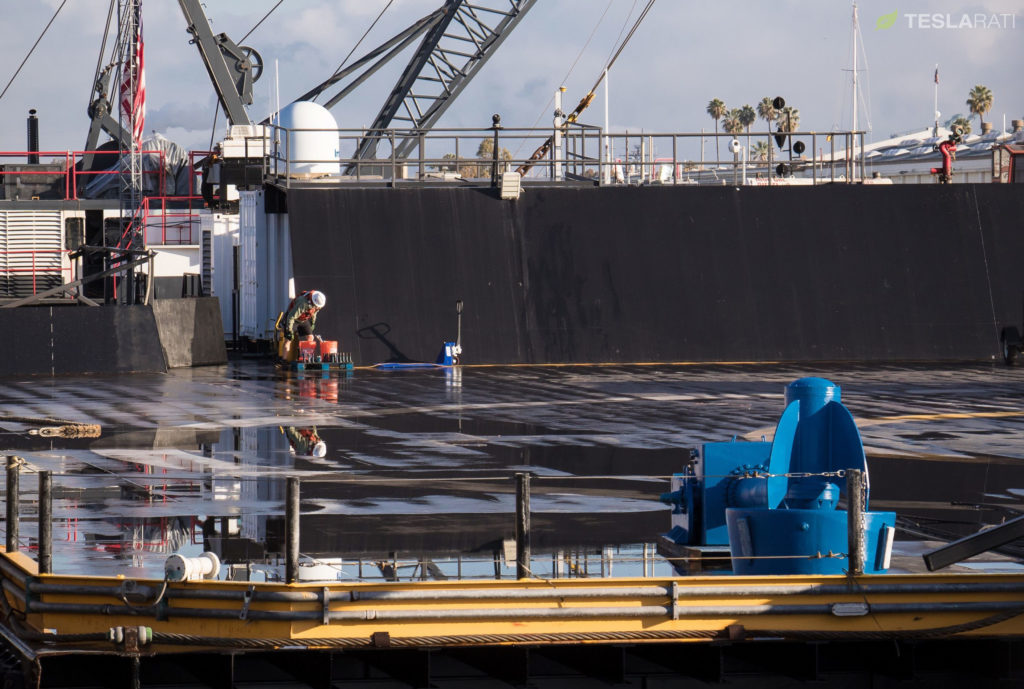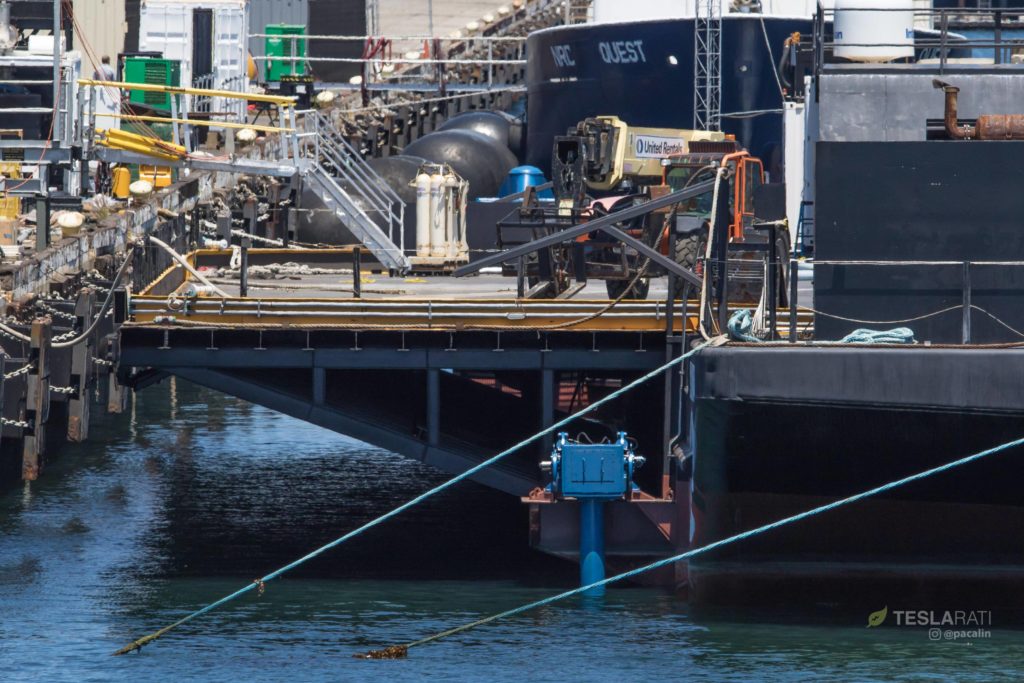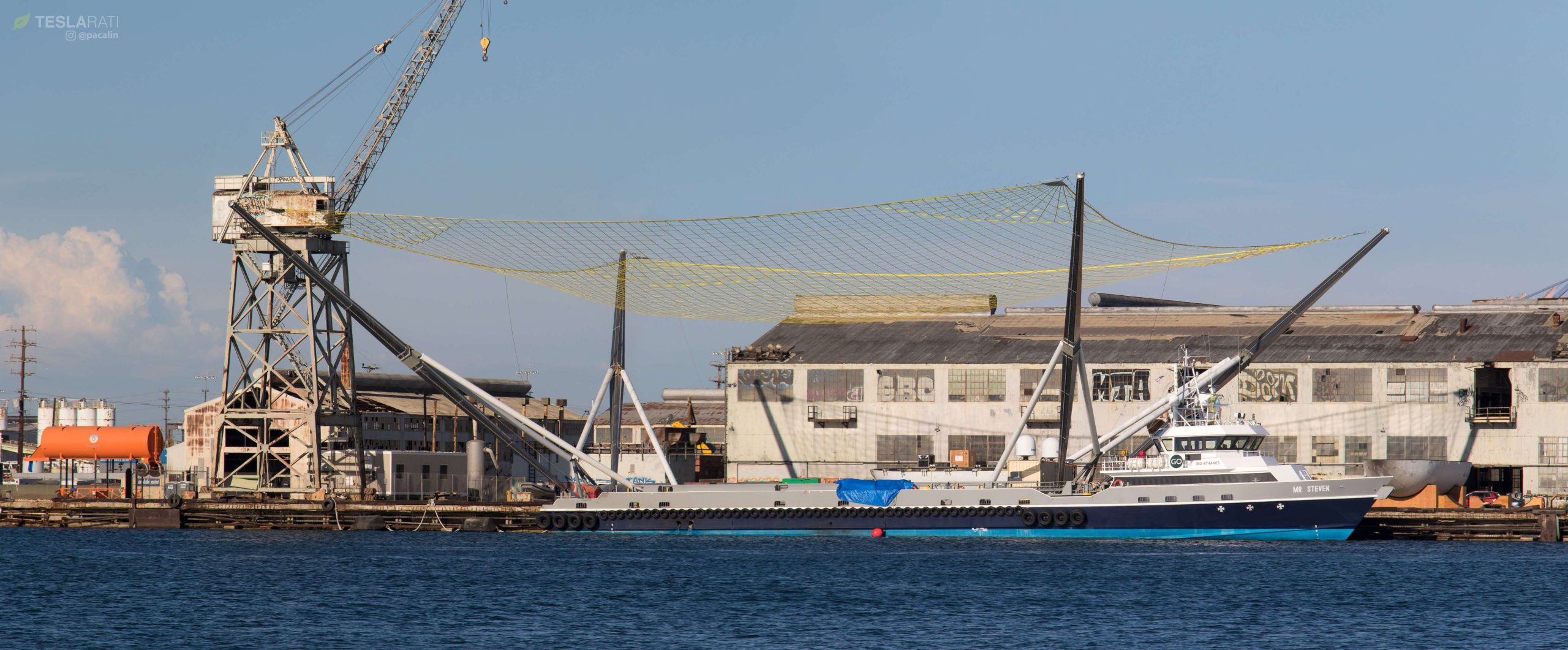
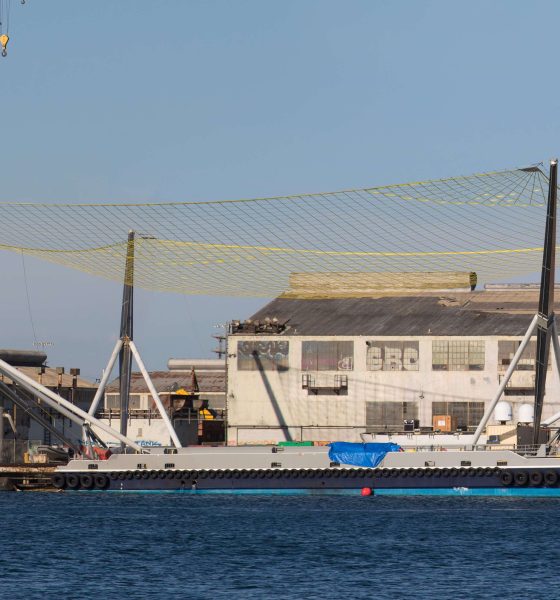
News
SpaceX’s Pacific rocket recovery fleet heads to sea for Western Block 5 debut
SpaceX drone ship Just Read The Instructions was spotted by Teslarati photographer Pauline Acalin departing Port of Los Angeles on the evening of July 22, while fairing catcher Mr Steven completed final checkouts and full installation of his massive new net, hopefully just days away from the first successful fairing catch. Their call to action, Iridium NEXT-7, is scheduled to launch NET 04:39 PDT/11:39 UTC, July 25th.
Over the course of July, both vessels have been undergoing significant maintenance and upgrades. Mr Steven’s was perhaps the most extreme – his original arm and net apparatus was removed in its entirety and replaced with a massively upgraded system of arms, booms, and a brand new net, well and truly expanding the vessel’s catching area by a factor of four.
With a new net and arm span stretching at least 60 meters by 60 meters, Mr Steven’s improved fairing catching mechanism is now almost the same size as the landing area aboard SpaceX’s two autonomous spaceport drone ships – roughly 200ft x 300ft (60m x 90m). While presumably a pure coincidence, the size parallels apparently necessary to recover two very different components of Falcon 9 – the booster rocket and the payload fairings – is rather satisfying.
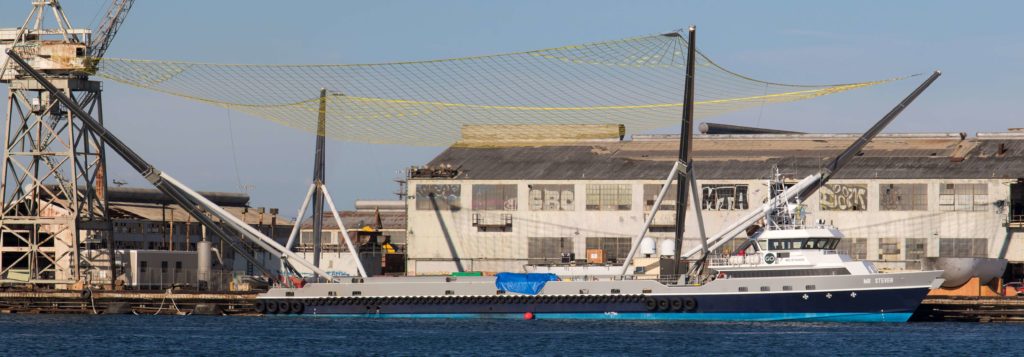
A last hurrah?
Intriguingly, ASDS Just Read The Instructions has stoically remained at SpaceX’s Port of San Pedro, CA berth for more than nine months, wholly unused despite the fact that the company has completed four additional missions since its last tasked booster recovery (October 2017, Iridium-3). It’s not a coincidence that all four of those Vandenberg AFB missions featured boosters that had already successfully launched and landed once before – SpaceX made a habit over the last four months of intentionally expending Falcon 9 boosters after their second missions, even when the launch conditions would allow for booster recovery.
This mission will thankfully bring an end to that understandable but still-painful practice, thanks to Iridium-7’s new Block 5 booster, B1048. Many of the months JRTI spent at berth were without the pod thrusters the drone ship needs to keep itself at the proper landing point once at sea, but JRTI departed the port with a full complement of four blue thrusters on the evening of July 22. However, it’s unclear how much SpaceX will need the vessel within just a month or two from today.
- A SpaceX technician works aboard the rain-soaked drone ship Just Read The Instructions, March 2018. (Pauline Acalin)
- More recently, all four thrusters were installed and tested both while berthed and at sea. May 11. (Pauline Acalin)
- JRTI captured conducting sea-trials by photographer Chuck Bennett. (Instagram, @chuckbennett)
At long last, SpaceX’s planned, built, and now-patiently-waiting West Coast landing zone is finally finished, permitted, and in the green to begin supporting Falcon 9 return-to-launch-site (RTLS) recoveries at Vandenberg Air Force Base. Effectively a basic copy of SpaceX’s now well-worn landing zone pair in Cape Canaveral, Florida, the company’s VAFB LZ-1 has been hinted at in two FCC launch permits for launches as early as the first and last weeks of September. Aside from Iridium launches, of which just one will remain after Iridium-7, nearly all of SpaceX’s West Coast launches are for fairly lightweight payloads that should easily allow Falcon 9 RTLS recoveries.
- Iridium-1’s successful and scenic landing on Pacific drone ship JRTI, January 2017. This could be an increasingly rare occurrence in the Pacific, thanks to SpaceX’s new land-based landing zone. (SpaceX)
- SpaceX’s West Coast landing zone is preparing for its debut, currently NET October 6th 2018. (Pauline Acalin/Teslarati)
Environmental conditions mean that JRTI will still be needed regularly for a handful of months (March through June) to avoid disrupting baby seals (pups, technically), but the vessel’s recovery efforts this week may be one of the last ‘off-season’ examples for months or even years to come. On the plus side, RTLS recovery at SpaceX’s VAFB landing zone will be an absolute dream for recovery technicians, as the LZ is directly beside the launch pad and hangar, where recovered Block 5 boosters can likely be refurbished or at least easily packaged and shipped to the Hawthorne factory.
For more sneak peeks and exclusive behind-the-scenes footage of SpaceX’s rocket recovery fleet, including drone ship Just Read The Instructions, be sure to subscribe to our exclusive membership program!

News
Tesla China delivery centers look packed as 2025 comes to a close
Needless to say, it appears that Tesla China seems intent on ending 2025 on a strong note.

Tesla’s delivery centers in China seem to be absolutely packed as the final days of 2025 wind down, with photos on social media showing delivery locations being filled wall-to-wall with vehicles waiting for their new owners.
Needless to say, it appears that Tesla China seems intent on ending 2025 on a strong note.
Full delivery center hints at year-end demand surge
A recent image from a Chinese delivery center posted by industry watcher @Tslachan on X revealed rows upon rows of freshly prepared Model Y and Model 3 units, some of which were adorned with red bows and teddy bears. Some customers also seem to be looking over their vehicles with Tesla delivery staff.
The images hint at a strong year-end push to clear inventory and deliver as many vehicles as possible. Interestingly enough, several Model Y L vehicles could be seen in the photos, hinting at the demand for the extended wheelbase-six seat variant of the best-selling all-electric crossover.
Strong demand in China
Consumer demand for the Model Y and Model 3 in China seems to be quite notable. This could be inferred from the estimated delivery dates for the Model 3 and Model Y, which have been extended to February 2026 for several variants. Apart from this, the Model Y and Model 3 also continue to rank well in China’s premium EV segment.
From January to November alone, the Model Y took China’s number one spot in the RMB 200,000-RMB 300,000 segment for electric vehicles, selling 359,463 units. The Model 3 sedan took third place, selling 172,392. This is quite impressive considering that both the Model Y and Model 3 are still priced at a premium compared to some of their rivals, such as the Xiaomi SU7 and YU7.
With delivery centers in December being quite busy, it does seem like Tesla China will end the year on a strong note once more.
News
Tesla Giga Berlin draws “red line” over IG Metall union’s 35-hour week demands
Factory manager André Thierig has drawn a “red line” against reducing Giga Berlin’s workweek to 35 hours, while highlighting that Tesla has actually increased its workers’ salaries more substantially than other carmakers in the country.

Tesla Giga Berlin has found itself in a new labor dispute in Germany, where union IG Metall is pushing for adoption of a collective agreement to boost wages and implement changes, such as a 35-hour workweek.
In a comment, Giga Berlin manager André Thierig drew a “red line” against reducing Giga Berlin’s workweek to 35 hours, while highlighting that Tesla has actually increased its workers’ salaries more substantially than other carmakers in the country.
Tesla factory manager’s “red line”
Tesla Germany is expected to hold a works council election in 2026, which André Thierig considers very important. As per the Giga Berlin plant manager, Giga Berlin’s plant expansion plans might be put on hold if the election favors the union. He also spoke against some of the changes that IG Metall is seeking to implement in the factory, like a 35-hour week, as noted in an rbb24 report.
“The discussion about a 35-hour week is a red line for me. We will not cross it,” Theirig said.
“(The election) will determine whether we can continue our successful path in the future in an independent, flexible, and unbureaucratic manner. Personally, I cannot imagine that the decision-makers in the USA will continue to push ahead with the factory expansion if the election results favor IG Metall.”
Giga Berlin’s wage increase
IG Metall district manager Jan Otto told the German news agency DPA that without a collective agreement, Tesla’s wages remain significantly below levels at other German car factories. He noted the company excuses this by referencing its lowest pay grade, but added: “The two lowest pay grades are not even used in car factories.”
In response, Tesla noted that it has raised the wages of Gigafactory Berlin’s workers more than their German competitors. Thierig noted that with a collective agreement, Giga Berlin’s workers would have seen a 2% wage increase this year. But thanks to Tesla not being unionized, Gigafactory Berlin workers were able to receive a 4% increase, as noted in a CarUp report.
“There was a wage increase of 2% this year in the current collective agreement. Because we are in a different economic situation than the industry as a whole, we were able to double the wages – by 4%. Since production started, this corresponds to a wage increase of more than 25% in less than four years,” Thierig stated.
News
Tesla is seeing a lot of momentum from young Koreans in their 20s-30s: report
From January to November, young buyers purchased over 21,000 Teslas, putting it far ahead of fellow imported rivals like BMW and Mercedes-Benz.

Tesla has captured the hearts of South Korea’s 20s-30s demographic, emerging as the group’s top-selling imported car brand in 2025. From January to November, young buyers purchased over 21,000 Teslas, putting it far ahead of fellow imported rivals like BMW and Mercedes-Benz.
Industry experts cited by The Economist attributed this “Tesla frenzy” to fandom culture, where buyers prioritize the brand over traditional car attributes, similar to snapping up the latest iPhone.
Model Y dominates among young buyers
Data from the Korea Imported Automobile Association showed that Tesla sold 21,757 vehicles to the 20s-30s demographic through November, compared to BMW’s 13,666 and Mercedes-Benz’s 6,983. The Model Y led the list overwhelmingly, with variants like the standard and Long Range models topping purchases for both young men and women.
Young men bought around 16,000 Teslas, mostly Model Y (over 15,000 units), followed by Model 3. Young women followed a similar pattern, favoring Model Y (3,888 units) and Model 3 (1,083 units). The Cybertruck saw minimal sales in this group.
The Model Y’s appeal lies in its family-friendly SUV design, 400-500 km range, quick acceleration, and spacious cargo, which is ideal for commuting and leisure. The Model 3, on the other hand, serves as an accessible entry point with lower pricing, which is valuable considering the country’s EV subsidies.
The Tesla boom
Experts described Tesla’s popularity as “fandom culture,” where young buyers embrace the brand despite criticisms from skeptics. Professor Lee Ho-geun called Tesla a “typical early adopter brand,” comparing purchases to iPhones.
Professor Kim Pil-soo noted that young people view Tesla more as a gadget than a car, and they are likely drawn by marketing, subsidies, and perceived value. They also tend to overlook news of numerous recalls, which are mostly over-the-air software updates, and controversies tied to the company.
Tesla’s position as Korea’s top import for 2025 seems secured. As noted by the publication, Tesla’s December sales figures have not been reported yet, but market analysts have suggested that Tesla has all but secured the top spot among the country’s imported cars this year.
